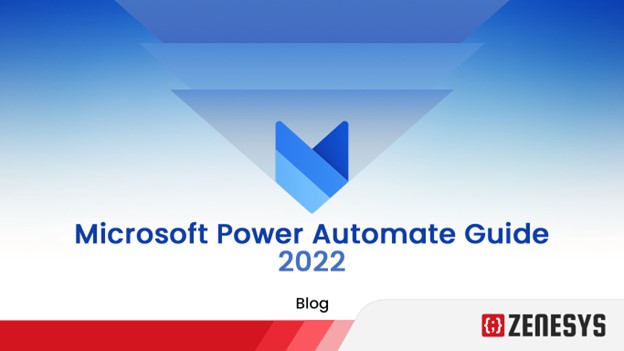As a result, organizations witness enhanced work efficiency and tremendous results. One such system is Microsoft Power Automate. It is another enterprise system from Microsoft. It is an online service that automates tasks and processes intuitively.
About 23% of organizations still don’t put RPA to good use. Robotic Process Automation has been serving as the building unit in the market currently. The demand to implement and use RPA is increasing significantly. This is where Microsoft Power Automate, previously known as Microsoft Flow, steps in.
What Is Power Automate?
A cloud-based system, Power Automate enables employees to build and work with the automated workflow. These workflows can be placed within various applications. All of this is achievable without the requirement to write a single line of code.
.png?width=590&height=257)
The flows are termed automatic workflows. An employee or the user defines the action to be taken during the occurrence of a specific event. This way, the employees can automate the repetitive tasks within various programs and applications.
As automation takes over repetitive processes and business functions, it paves way for increased efficiency and productivity.
Basic Features of Microsoft Power Automate to Take Into Consideration:
- The Power BI connectors in the flow allow collaboration with the third-party database systems. This way it enables organizations to access analytics.
- The automation using the templates and a zero-code UI happens with just a click.
- The project group manages the workflow together to build complex team flow.
- RPA observes and records all the actions that include a mouse click, keyboard keys, an entry in the database, which it replicates and automates the workflows.
- With accessibility to mobile apps, running the automated tasks on the go becomes easy.
Why Choose Power Automate?
Additionally, the IT team should use Power Automate Desktop to automate certain tasks so that they can focus on other core functions.
Microsoft Power Automate Offers Access to Four Different Types of Flow:
1. AUTOMATED:
It kickstarts events in a product or service.
2. INSTANT:
This is started when a user taps a button on mobile or clicks a button on the website.
3. SCHEDULED:
This triggers actions as per a defined time schedule predefined by a user.
4. BUSINESS PROCESS:
This is similar to wizards. But you have to work with a particular business workflow. This includes onboarding a new client or changing the details of an account from one type of service to another. Such a flow offers a visual understanding to display the consumer journey at the selected point of time during the process.
What is a Connector in Microsoft Power Automate?
Power Automate offers access to over 220 applications along with other services. These include the popular connectors viz. Microsoft Dynamics 365, OneDrive for Business, MailChimp, and more.
When you have a discussion using MS Teams, the Flowbot is designed to pick up the phrases you use during the discussion. It flags those phrases for the manager or shoots an email in another department. This all happens while we are discussing the agenda within Teams.
RPA Function in Microsoft Power Automate:
The RPA function in Power Automate is known as UI flows. It records and plays the actions taken by humans within the software system. These software systems are typically those that do not support the automation of API.
This is where RPA takes up the manual tasks and converts them into automated workflows. Microsoft Power Automate Desktop offers access to pre-built connectors for about more than 275 apps and services that are compatible with API automation.
You may also Like: Uipath vs Automation Anywhere vs Blueprism
Benefits of Using Microsoft Power Automate in Your Organization:
There are various benefits of introducing and implementing Power Automate in your organization. They are:
1. EASY DATA TRANSFER:
Using connectors, the data transfer happens effortlessly in a very short period of time. It allows the exchange of the data and the important data is easily accessible.
2. ZERO CODINGS:
Microsoft Flow Power Automate is a cloud-based tool that enables anyone to automate tasks and workflows. In addition to this, they don’t need to write a single line of code. It is simply an array of clicks.
3. EFFORTLESS COLLABORATION:
It is completely effortless to connect and collaborate Power Automate with other applications. The connectors play a huge role in making this possible. A connector connects two or more applications and then enables the exchange of information and data.
4. AUTOMATED AI CAPABILITY:
Power Automate comes with predefined AI abilities that turn tedious and repetitive tasks into automated ones. This enables the employees to focus on other important tasks within the organization. They can handle challenges in the organization instead of spending time on repetitive tasks.
5. ENHANCED EFFICIENCY:
The tool allows you to introduce flexibility in the workflows. This includes small to heavy tasks and processes. This saves a lot of time and improves performance efficiency to a significant extent.
Conclusion
Microsoft took revolutionary action to develop Microsoft Power Automate. It is the right tool to organize complex tasks into a comprehensible structure. Power Automate takes away a lot of burden and mundane tasks from the employees’ shoulders. And as we previously saw, this allows them to focus on other challenging tasks. When it comes to tech-savvy organizations, Microsoft Power Automate is the right tool to use. In the years to come, Power Automate will change the way businesses work.
Also Read: What is RPA and How can it Help to Grow Your Business?


.webp?lang=en-US&ext=.webp)

.webp?lang=en-US&ext=.webp)

